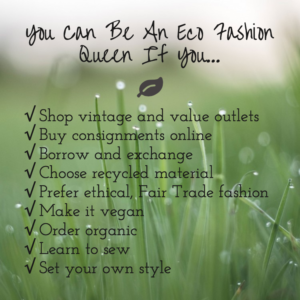What does it take to manufacture, sell, and dispose of clothing? You might be surprised. The clothing industry is one of the most environmentally intensive in the world. If it’s made from cotton, it’s been doused with as much as 22.5% of the pesticides applied to agricultural crops worldwide. If it’s made from a synthetic fiber, its source is actually coal or oil. As much as we might prefer to wear fig leaves, when we have to wear fabrics, what should we choose?
The Green Moms Carnival tackles the clothing conundrum this month. Most of us bemoan how difficult it is to figure out how to buy environmentally-friendly fashions in the first place.
Mary of In Women We Trust regrets how few organic fabrics are designed for the boardroom instead of the beach, and points out the valuable role that the Global Organic Textile Standard (GOTS) play in ensuring that textiles are produced organically.
Amber at Strocel.com compares polyester and acrylic, two synthetics made from fossil fuels, and comes down on the side of buying less clothing over all, and natural fibers over synthetics. “Reducing consumption pretty much always comes out ahead,” she notes.
Anna at Green Talk provides a comprehensive analysis of the use of recycled plastic bottles in clothing, as well as other textiles. A big concern is that textiles made from recycled plastic emit the chemical antimony, which has been linked to a wide variety of health problems in laboratory animals. Anna also reports that demand for plastic bottles that can be recycled into textiles has risen so much that some manufacturers are using brand new plastic bottles, rather than recycled ones. Talk about the law of unintended consequences!
Linda at Citizen Green points out several benefits to using recycled plastic, like the fact that “30% less energy is needed to down cycle the bottles into shirts than is needed to make them out of virgin plastic.” So what’s the worry? Plastic is still plastic, and will take hundreds of years to biodegrade.
Sarah of Practically Green provides a great set of tips if you’re shopping vintage. “Don’t keep it if you will NEVER be that size again,” she suggests — good advice whether you’re buying old or new. You’ll also love her pictures of the vintage clothes she’s snagged over the years, from a snazzy leopard clutch she lined with red leather (see photo, right) to her dad’s v-necked, cashmere sweater.
Keep reading. There’s more!
Lynn of OrganicMania goes for classics that never lose their style. While they might not be made from “eco friendly fibers,” these designs last forever – a real value in these days of fast, disposable fashion. Read Lynn’s post to get the inside scoop on her favorite retailer – a savvy store whose consistent color schemes and excellent craftsmanship make it possible to extend the life of any of the businesswear she buys there.
Micaela of Mindful Momma warns against actually buying clothes labeled as “smart” – since they may be loaded with “specialty fibers infused with all sorts of chemicals and technology” that may cause more problems than they fix. Micaela worries that “these products and technologies have not been thoroughly tested for safety on humans. Nor do we know the impact on the environment. Will the great new technology of today be the BPA of tomorrow?”
Jenn at the Green Parent suggests eco-friendly alternatives to clothes treated with fire retardants (aka, nasty chemicals that have been linked to a host of developmental health problems). High on Jenn’s list is organic merino wool, which is soft and naturally resistant to fire.
At Crunchy Chicken, Deanna raises a red flag about dangerous lingerie. While acknowledging that these garments “aren’t exactly meant to be worn for long,” Deanna notes nevertheless that the bustiers, bras, and corsets sold as “adult wear” are not made from fabrics you should be putting near your genitalia, “due to residual formaldehyde, flame retardants, and polyurethane.” A better alternative to these sexy but not-so-safe play clothes? A non-toxic or edible body paint. Chocolate, anyone?
At Big Green Purse, I tackle the question of bamboo. Is it green…or greenwashed? I compare bamboo to conventionally manufactured cotton (an exercise that would be so much easier if sustainable standards were in place) and find, that on several measures bamboo comes out ahead. However, organic cotton would still be my fabric of choice, and my post explains why.
Karen at Best of Mother Earth thinks the solution may be to sew clothes herself…if she knew how. That way, she’s sure the clothes she wearts will fit her criteria: “I have to feel and look good in it…it can’t cost a fortune…I won’t dry clean it…and does it even fit me?”
Maybe she can take a sewing lesson from Lisa at Condo Blues. Lisa learned how to sew without wasting fabric from her mom, and she’s heartened at the efforts the fashion industry is making to reduce its trash, too. Take a look at the knock-out Renaissance-era gown Lisa recently sewed, and you’ll be begging her to make some garb for you.
What about how much clothes cost? Lisa at Retro Housewife Goes Green reveals the costs hidden in the manufacture of clothes, noting that many designs today are manufactured in sweat shops that only pay a fraction of the decent wages laborers deserve. Lisa suggests buying designs certified as Fair Trade to ensure that workers receive a fair payment for their work.
Tracy at Inspire Planning addresses the cost issue as well – as in how much money you can save by buying “green.” To her that means, shopping for gently worn clothes that are fashionable, swapping clothes with friends and neighbors, and shopping online at reasonably-priced eco-designers. Another savvy tip? Peruse your favorite design magazines and websites to get a sense of current fashion trends, then dress up clothes you already have in your closet with accessories like scarves and hats.
Most of these posts link to additional resources on topics like eco-friendly shoes, handbags made from recycled materials, and more. Hope you’ll browse the “racks,” figuratively speaking of course.













7 thoughts on “Clothing: What’s Eco, and What’s Not”
Enjoyed reading your post and am glad to see a growing awareness to this issue.Our company follows a triple bottom line approach to apparel and fashion, people, planet, and prosperity. A portion of the proceeds from the sale of our products is reinvested in infrastructural projects worldwide to help create self-sufficiency for people and communities in need. Our products require no new natural resource and no new color dyes and are made from 100% recycled fibers, (recycled pre-consumer colored cotton from cutting room and textile manufacturing waste and recycled polyester from post-consumer plastic bottles). We spin new colored yarns, knit new colored fabrics, and produce new vibrantly colored, functional and fashionable clothing from materials that otherwise end up in landfills. Equally or more important is that the care of the clothing after purchase requires no bleach, cold water washing and quick drying. Thanks for writing about this subject and helping to educate and create conscious consumers.
Thanks,
Mark Heiman
Tulong LLC
http://www.repairtheworldnow.com
Hi Diane,
I thought you might find this interesting:
http://www.tulongllc.com/press-room/csrwire-press-release-93010/
Thanks,
Mark
Thanks for hosting!!
Great list! Thanks for sharing! And yes, sustainable clothing should be cared for by washing in cold water with ecological laundry products. Good point, Mark.
-Deb for Ecover
What an incredible post with such a wealth of information! I am a brand new blogger and would love to participate in the Green Mons Carnival sometime. Thanks for sharing. Oh, and to add my two cents, I am personally a fan of shopping second hand for most of our family’s clothing, I have even been lucky enough to find some great organic cotton and bamboo clothing at garage sales and thrift stores!
Smiles,
Terri
http://www.EcoCrazyMom.com
Terri, You can see the blogging schedule for the Green Moms Carnival at organicmania.com. Please check it out! We’d love to have you add your voice to the Carnival.
I love bamboo clothing. It’s such a great fabric especially for summertime, it will keep you nice and cool. Definitely was with environmentally friendly soaps. There’s a good variety of environmentally soaps available now and hopefully we’ll be getting more. A plethora of fantastic information. Thank you for sharing!
Comments are closed.